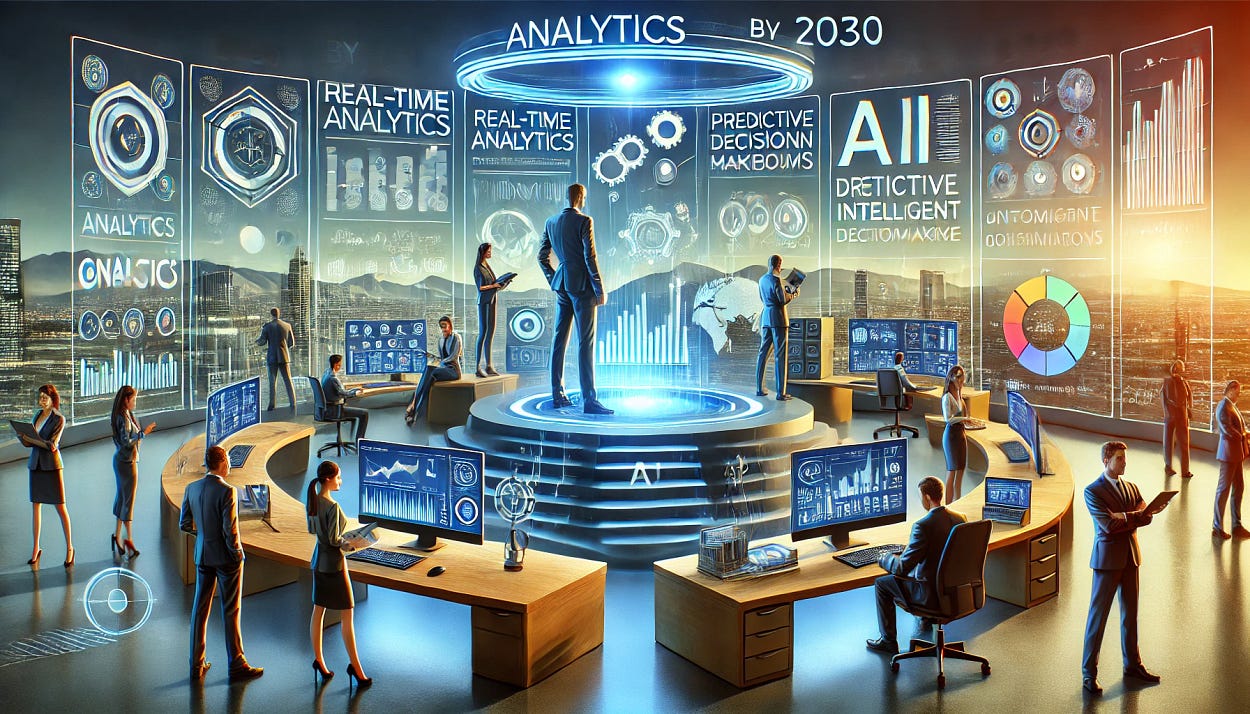Analytics as an Operational Process: Bringing It All Together
Driving the Analytics of 2030, not 2020

The future of analytics isn’t just about better dashboards or faster reports — it’s about rethinking how we harness data to drive competitive advantage. In my full article, Driving the Analytics of 2030, Not 2020, I explored how organizations need to shift their mindset and strategy to keep pace with the evolving analytics landscape.
Let’s zoom out and conclude our journey. By 2030, what will it look like to truly run on data? A few parting thoughts and an inspiring vision:
Analytics is a Continuous Loop
Instead of one-off projects or reports, analytics will be a continuous process embedded in operations. Data is collected (sensors, transactions, interactions), it’s analyzed in real-time, insights are generated, decisions are made, actions are taken, which in turn generate new data… The loop keeps spinning, faster and smarter each time. Companies will evolve “Analytics Ops” practices (akin to DevOps in software) to manage this continuous analytical process, ensuring models are updated, insights are integrated, and value is tracked.
Decision Intelligence
There’s a buzzword “decision intelligence” which basically means combining all techniques (data science, social science, managerial science) to improve decision-making. I see by 2030 many organizations will explicitly focus on this — not just producing insight, but making sure it leads to better decisions. This could involve simulators for decisions (like a business war-room where you test a decision virtually using data models before implementing) or scenario planners. It’s the maturation of analytics from informative to truly transformative.
Everyone’s an Analyst (with an AI Sidekick)
We mentioned democratization — “90% of analytics consumers become creators”. The vision is every employee can be an analyst when needed, asking and answering questions in data. And they won’t do it alone; they’ll each have AI sidekicks. Picture a future intern in 2030: on day one, they not only get a laptop, but also access to a company-specific AI assistant that briefs them on any data they need, answers questions, and guides them through analyses. That intern can contribute insights in week one that might’ve taken months of onboarding in the past. Empowerment at scale!
Read more: [Gartner’s top data & analytics predictions for 2025 — DataGalaxy](<https://www.datagalaxy.com/en/blog/gartners-top-data-analytics-predictions-for-2025/#:~:text=Gartner’s top data %26 analytics,predictions for 2025)
Strategic Alignment through Analytics
Tools like the X-matrix and balanced scorecards have helped align strategy for years, but by 2030 they will be dynamic. If the CEO updates a strategic goal, the ripple effect down to every team’s metrics will update in software, and every employee can see how their analytics tie to the big picture. This alignment, combined with transparency, means analytics isn’t happening in silos; it’s woven to strategy. Danaher’s X-matrix approach ensures that, and companies will emulate it with digital platforms so that at any time, anyone can see “how are we doing on what matters?” and “what’s my role in it?”. As the Hoshin Kanri experts say, it’s about connecting high-level vision to day-to-day data and actions.
Read more: [Measuring Hoshin Kanri: bowling charts and A3 reports](<https://blog.i-nexus.com/bowling-chart-a3-reports-measure-drive-hoshin-kanri#:~:text=X,the strategy prior to execution)
Innovation and Fun
Lastly, I want to stress that this future can be fun and human, not just robotic. When mundane analysis is automated, analysts can focus on creative problem solving — the “whys” and “what’s next” — which is the intellectually rewarding part. Analytics will become more exploratory and experimental. With rich data simulations, you might gamify decision-making (“Let’s play out scenario A vs B and see which our data predicts will win!”). Leaders will rely on data but also on their imagination to question the data and ask novel questions. The best organizations will keep a balance: data-driven but not data-blinded (knowing when to use human judgment).
In conclusion, business analytics by 2030 will be like driving a modern car with an advanced driver-assist. The dashboard (analytics dashboards) gives you real-time metrics like speed and fuel (KPIs), the GPS plus AI (augmented analytics) suggests optimal routes and alerts you to hazards (prescriptive insights), and some functions might even automate (think self-parking = automated decisions). But you remain the driver, setting the destination and making the final calls. Companies that embrace this symbiosis of human and AI — much like I, a human, partnered with AI to write this article — will navigate the road to 2030 with confidence and success.
The future of analytics is inspiring, inclusive, and intelligent. It’s a future where data is not just a byproduct or a report, but a living, operational heartbeat of the organization — guiding every beat and breath the business takes. If you start building the culture, skills, and systems today, by 2030 you won’t just be keeping up with the times — you’ll be leading the charge, dashboard gleaming, on cruise control toward your strategic vision, powered by insight.
So, here’s to the exciting journey ahead — let’s drive our businesses with data, and enjoy the ride!